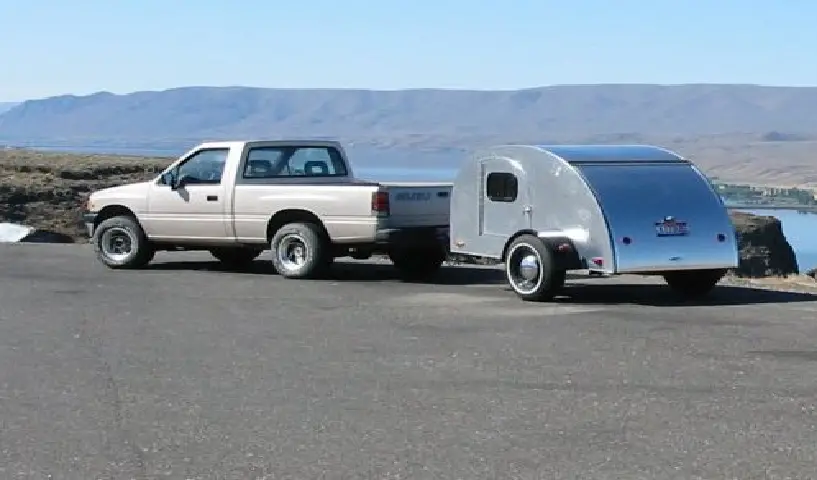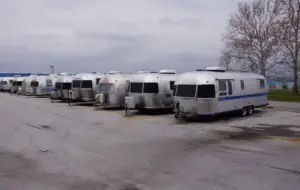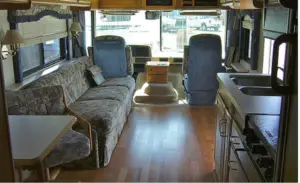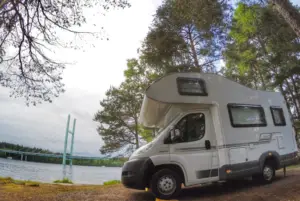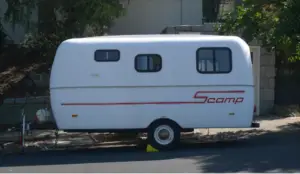In the sweltering summer season, outdoor enthusiasts love to explore nature without sacrificing the comforts of their homes. A modern teardrop camper can have all the amenities you need.
Not to mention, it’s easy to haul if your car has a hitch. This is a surefire way to get off the beaten path for a true adventure. And when you hit that unbearable heat, an AC unit can provide refuge.
Here is everything you should know about installing AC on teardrop campers.
Do teardrop campers come with ac?
Teardrop campers are lightweight and tiny, so most of them don’t come with AC units right off the bat.
However, some companies offer air conditioners as an extra amenity, but this will cost you.
Can you add ac to a teardrop camper?
Most teardrop campers allow for the installation of a 5000-BTU air conditioner.
But for it to work, you should plug in an electrical hookup. An AC unit can fit in the wooden compartment of your camper.
When you add an AC unit, no condensation can trigger mold and mildew buildup. But again, it should be sufficient to cool 100-150 square feet.
When choosing an AC unit for your camper, you may want to go for ductless models.
They can sit inside a window, wall opening, floor, under a bench, or on the rooftop. Also, they allow the air through multiple vents and are easy to open.
Ductless units have a compressor, blower, condenser, and aerodynamic casing. Most models come with foam filters, so you should be ready to clean them once a month.
Another consideration is generator wattage. If the AC runs on 5000 BTU, you need a 2000W generator. And most importantly, you should invest in a unit that produces low decibels of noise when running.
At this point, you may be considering getting an AC unit if your teardrop doesn’t have one. On average, you must be ready to spend $400 to $700 for an AC unit.
It’s mostly up to you to decide whether to install yourself or let the professional do the job. If you’re not sure where to start, a technician can do the job right the first time.
Make sure you buy an air conditioning unit that comes with hoses, quick-connect flanges, and an assembly kit.
For a teardrop camper, an AC that runs at 110V can be a sure bet. If the unit gets low wattage, it will still operate, but you won’t get optimum performance.
How to install AC in a teardrop camper
If your teardrop camper doesn’t come with an AC unit, the inside can feel like an oven. Since an air conditioner is like a window unit, you can install it on any wooden compartment of your teardrop.
With the basic tools, you can do the job without prior experience. A general rule of thumb is to install the unit at the foot level. If you don’t know where to start, you can consult the manual for installation instructions.
Of course, the steps for preparing, mounting, and installing will depend on the brand and model you choose. Here is a simple step-by-step guide.
Tools needed
You need a screwdriver, brackets, cordless drill, pliers, tin snip, and a measuring tape.
Safety comes first
Before anything else, you should ensure the power sources are disconnected.
Next, get rid of appliances or devices that contain flammable gases. And the drain hose pipe should not contain water during the time of installation.
Installing the AC during the day is the best option because you can use natural light.
Pick a location
You ought to pick a convenient location – it’s up to you to choose a place where you can optimize the airflow. How do you want the AC to feel in the camper?
But here is the thing – most 5000 BTU AC weigh between 40 and 60 pounds. While this may not sound like a lot, it will affect the weight distribution in your camper.
When choosing a location, you should ensure one side is not heavier than the other. If you’re not careful, you risk damaging your teardrop.
Cut the hole on the side of the trailer
A 14 X14 inch hole can support a 5000 BTU AC to pull in ambient air from outside. After that, cut another hole behind the AC unit to ensure the hot air is not entering back the trailer. Keep in mind the air is blown through the condenser coils for cooling.
Divide the space into three distinct zones
The first zone pulls the cabin air while the second zone pushes the air into the middle section.
The third zone provides air in mid-section vents. Then, provide the exit route of the heated air.
Water collection space
You must put into consideration the condensation created by the unit after cooling the air.
Generally, an air conditioner can pull water and cause it to evaporate quickly. That’s why you should ensure it leaves the trailer completely.
Your AC will collect water in zone two and three. It’s recommended that you invest in a model with a built-in drip pan. But again, you can install a collection pan where water can drain out.
Alternatively, you can drill a hole at the bottom and attach a hose to create some sort of funnel. If you don’t catch the condensation, be ready to find the floor of your teardrop flooded with water.
Install the AC unit
For a watertight installation, use weather-proof sealant tape on any framed out areas. Another crucial step is to get the cuts and angles right.
Perhaps the most trying part of the build is using the separators and aluminum shields. For the best configuration, you can use foam stencils.
Clamping the unit
If your AC is more than 60 pounds, you don’t want to risk dragging it on the floor. And considering that these systems are delicate, you should be vigilant about how you carry the AC. Don’t be afraid to ask for help.
Depending on the model, you can get a distribution box, wires, connectors, and a temperature controller. You may want to refer to the manual to fix them.
Connecting the electrical supply
You should connect the unit to the power supply after wiring using the screws provided. You may also place a cover to protect the unit from rain.
Don’t forget to measure the wires correctly and give them a neat look. The user manual will give a better understanding of the connection.
Connect the wires
Disconnect the power source to reduce the risk of an electrical shock. After that, connect to the breaker of the converter box and supply power to external wires.
The wires must be long enough to reach the desired circuits. If they are tightly connected, they may disconnect soon. Always take extra precautions to avoid any mishaps.
Create external power cable connectivity
You can have a connector installed on one side of the wall through the air conditioning unit.
Reconnect the power supply
Take a few minutes to check all the connections before you turn on the power supply.
This includes checking the breaker, sockets, and junction box. If everything is in pristine condition, you can switch on the AC.
It’s recommended that you test the AC to try all the settings and features. That way, you’ll know where the problem is.
To ensure you get more from your AC, you should shut the windows. This helps to maximize the cooling potential as the cold air won’t escape.
What type of AC can you use with a teardrop camper?
You should use a 5000 BTU air conditioner that runs on 115V. Furthermore, it should have a dual hose system that allows for fast installation. Lower thermal units (2500BTU) mean an energy-efficient camper.
The AC unit should also have a dual hose system, and it gets better if you can find one that can work as a dehumidifier.
Since a teardrop camper doesn’t have much space, you want to choose a compact unit that allows the air to move in two ways.
The weight and performance of the air conditioner also matter. Make sure you confirm the details of the camper from the manual. Don’t be surprised to realize your teardrop trailer has a low capacity.
When making your investment decision, be sure to choose an energy-efficient air conditioning unit.
Do teardrop campers get hot in summer?
Teardrop campers are lightweight, compact, and well-insulated. If you’re an outdoorsy person, you can use your camper and take a long weekend joyride.
During the spring season, you’ll love the warm weather in the daytime and cool air as you settle for a night of sleep.
But summertime is a different story – your camper can get as hot as an oven. While you can rig up an oscillating fun, this will only shift the hot air to one side.
And because you can’t control the weather, an AC unit can keep the teardrop cool.
How difficult is it to live or camp in a teardrop camper during summer?
Camping in a teardrop trailer is the perfect way to get close to nature. But if you’re new to camping during the sweltering summer season, you might find it intimidating.
The most difficult part of camping in a teardrop is having cook inside. Sleeping gets more uncomfortable if you don’t cool the interior – even the most steadfast adventurer will struggle in summer.
If you’re a camping enthusiast, you may have realized the ventilation for teardrop campers is never enough.
How to keep it cool without AC
Summer comes with high temperatures depending on where your travel plans can take you.
If you don’t feel comfortable investing in an air conditioning unit, there are other ways to keep your camper cool.
Get portable fan
A battery-powered fan provides a blissful breeze all night. The best model should be lightweight and quiet.
It is a good idea to get a fan with foam blades. And one that can easily attach to the roof or camper’s floor.
Stay in the shade
One of the efficient ways to keep your camper cool is by keeping it under the shade.
If the environment doesn’t provide a shade, you can erect an overhead canopy.
Shield the windows
While you can use curtain blinds to keep the sun at bay, reflective insulation can provide an additional barrier. You can also add a reflective cover at the top of the camper.
Cook outside
When you cook outside, your AC unit won’t have to work harder, and you’ll feel comfortably warm. But one thing you must be mindful of is constantly opening the door.
Of course, you want to invest in an electric burner and grill. If possible, you can use a slow cooker.
Drink lots of water
Water is a natural coolant. Since our bodies are made of 60% fluids, keeping hydrated is the best weapon against overheating.
Insulate other areas of the camper
You can make some modifications to the sides of the teardrop camper. This will keep the compartments and the underbelly cool.
More importantly, you should seal the gaps that expose the outside air. This trick may not be necessary for low temperatures.
Make use of the breeze
Let’s face it: wind is nature’s air conditioning. Once you figure out the direction of the wind, you can open the windows of the camper to allow in the cool breeze.
In today’s technological designs, you can find campers with large windows.
Use breathable linens
Trying to stay cool at night in a teardrop camper can feel like taking laps in a sauna. Linen is the best material to use in your beddings. The lower the thread count, the more breathable it is.
Unlike other textiles like cotton and silk, linen fabric can make a big difference in your camper by 3 or 5 degrees. And this is no small change considering the limited space.
The best part of breathable linens is that you don’t have to change them during winter. They will do a good job at regulating the temperature to ensure restful sleep.
Install energy-efficient bulbs
If your camper has incandescent bulbs, you should use energy-efficient bulbs.
Wrapping up
Teardrop campers are suitable for people who want flexibility. You can go places where traditional RV can’t without sacrificing modern conveniences. If your camper doesn’t have an AC unit, you can still enjoy a comfortable stay in summer.
The installation process is straightforward – even someone with no electrical skills can do it. Be sure to follow the above guide to ensure you make a worthwhile investment.

